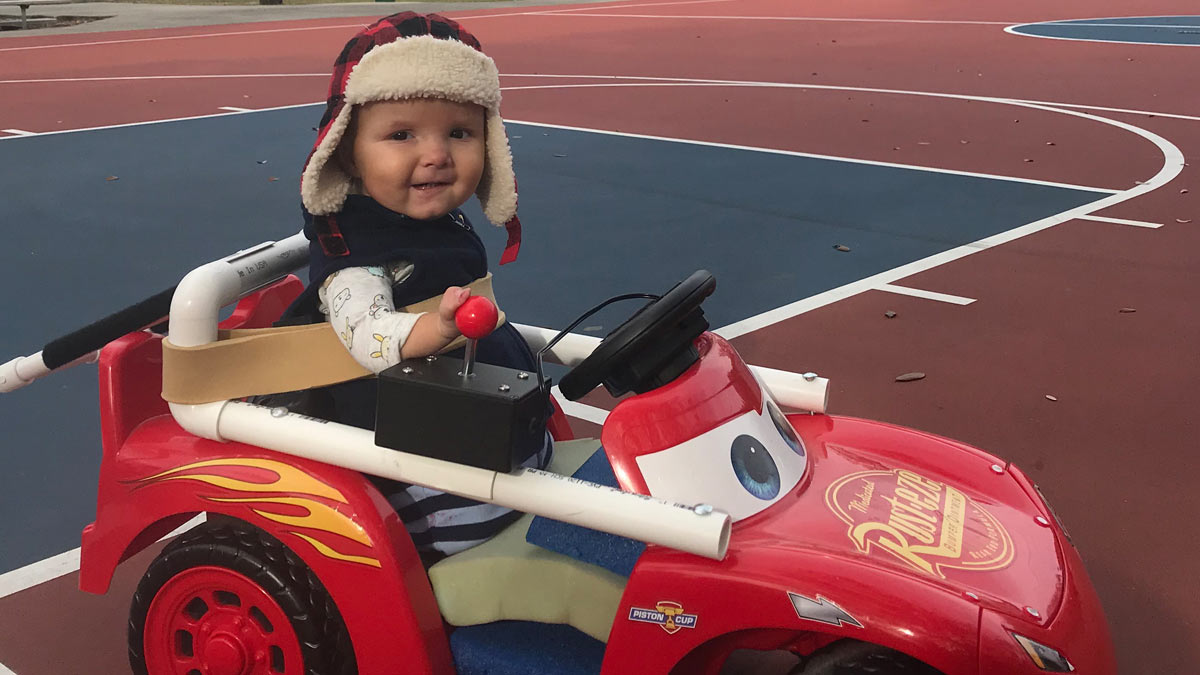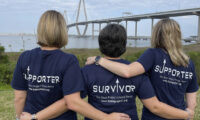Losing the freedom to explore your environment due to a mobility disability impacts all areas of development in a young child. The Medical University of South Carolina and Laing Middle School of Science and Technology in Mount Pleasant are partnering with Go Baby Go! to help young children with neuromuscular disorders get moving as soon as possible.
Go Baby Go! is a national, community-based research program that provides modified ride-on cars to young children with disabilities so they can move and explore their environment as independently as possible. Founded by Cole Galloway, director of the pediatric mobility lab and design studio and a professor at the University of Delaware, the program provides a fantastically simple solution to a complicated problem. Go Baby Go! has changed the trajectory of the lives of children around the nation with mobility disabilities.
Patty Coker-Bolt, Ph.D., OTR/L, FAOTA, professor and faculty member in the division of occupational therapy, and Cindy Dodds, PT, Ph.D., PCS, associate professor and PT pediatric residency director within the division of physical therapy at MUSC, both participated in rehabilitation conferences where Galloway shared research concerning Go Baby Go! In addition, published, peer-reviewed research from Dr. Galloway helped them quickly realize they could do this at MUSC and benefit children in South Carolina.
In 2013, Dr. Coker-Bolt and some students published a research article based on a case study using Go Baby Go! protocols for adapted ride-on cars. What she discovered was that these vehicles paved the way for small children to eventually use power wheelchairs by enabling them to develop motor skills they might never have mastered.
“A child typically learns to crawl and walk by the age of 1,” Dr. Dodds explained. “The ability to explore their environment contributes to the development of not only motor skills but also important language, cognition and social skills.”
Dr. Coker-Bolt added, “If children can’t move and explore their environment, they may not grow in crucial areas, and an established pattern of learned helplessness is created. Providing children with a disability-impairment modified car, changes that dynamic. Suddenly, they feel autonomous with an ‘I am, I can and I can do’ attitude.”
Drs. Coker-Bolt and Dodds provided an example of a child who was born with limb deficiencies and was given a Go Baby Go! car at 8 months old. Remarkably, and beyond the normal trajectory of development, by 18 months, this child was provided a power wheelchair and could successfully and safely control this 500-pound piece of equipment in home and community environments – not a typical expectation of any 18-month-old child with or without a disability.
“You will be amazed by what children can do when they are given the power and trust to make the right decisions,” maintained Dr. Dodds. “This ride-on toy car was his first chance to show people that he had an understanding of how to use his body to move a vehicle within this environment. Without it, it may have been hard to show the health insurance company that he could use such an expensive and large piece of equipment. Today, he is totally independent in his power wheelchair.”
A Go Baby Go! car can literally change a young child’s world at a minimal expense – A car can be easily modified for about $300. Besides affordability, another advantage is that the lightweight vehicle is easy to transport and take to malls, parks and other community settings to encourage socialization.
“This is not your typical piece of rehab equipment. This is a toy car,” emphasized Dr. Coker-Bolt. “When patients are in one, other kids feel more comfortable coming up to talk to them, and sometimes that is the first time that has ever happened. Having a car just like all the other kids promotes inclusion and social participation.”
So how does it all work exactly? Dr. Dodds explained that, in the beginning, the MUSC College of Health Professions was buying the cars and completing all electronic and seating support modifications in-house and also training the child and family in the use of the car.
But as the toys became a little more intricate, working on the electronics became more difficult. Enter Laing Middle School of Science and Technology, where STEM Coach Mel Goodwin had signed the school up as a Go Baby Go! partner in 2018. Today, MUSC still does the seating support modifications for kids with development delays and disabilities after Laing students modify the electronic components.
“We love the relationship we have built with Laing. It’s a great collaboration,” said Dr. Coker-Bolt. “We need the cars to be absolutely safe, and they do a wonderful job. Plus, they have done some cool things with remote control options.”
Dr. Dodds added that the cars can jolt when they start and stop, and the Laing students are able to modify them for a smoother transition, which is particularly important for children with marginal head and trunk control. It allows the students to learn a pretty unique skill set and learn empathy.”
Eight years later, Drs. Dodds and Coker-Bolt estimate they get 20 requests a year for modified cars.
“We give cars to children across the state, not just MUSC children,” explained Dr. Dobbs. “Patty is in OT, and I am in PT. We both have state and national organizations we work with and have taught other PTs across the state how to build these. We also teach roughly 120 students each year between us, and we show them firsthand the importance of early power mobility. They help spread the word. Most of the referrals come from outside therapists or our graduates.”
Do you know a family that might benefit from a Go Baby Go! Car? Email Dr. Dodds at doddscb@musc.edu or Dr. Coker-Bolt at cokerpc@musc.edu to learn more.
By Pamela Jouan







